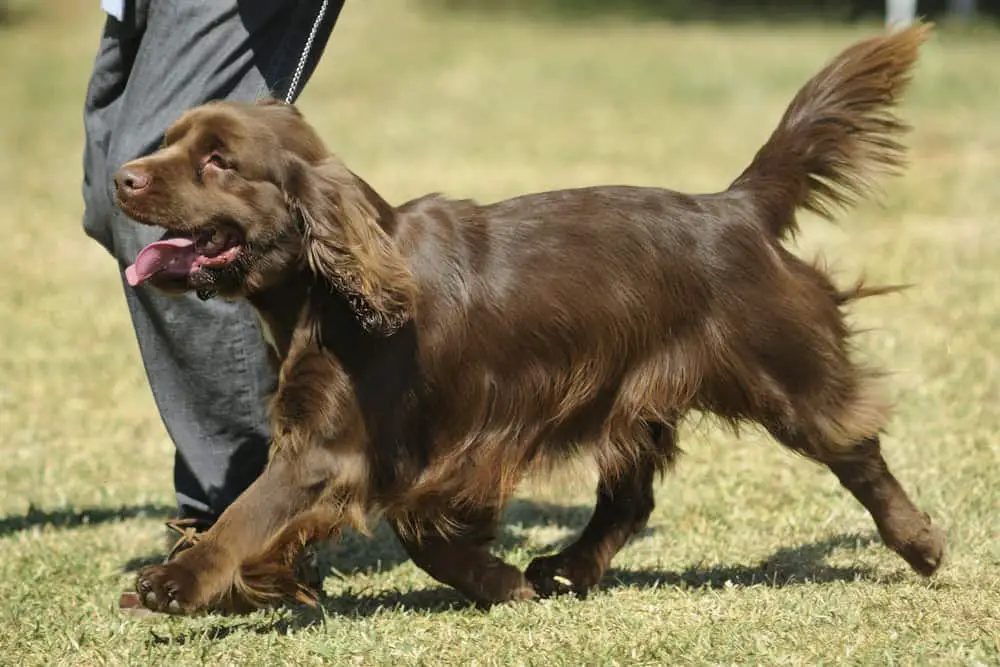Complete Guide To The Sussex Spaniel: Grooming, Feeding, Personality and More
Guide to The Sussex Spaniel British breeders love their hunting dogs, and their dedication shows in the Sussex Spaniel. Renowned for their short stature and merry personality, they’re always entertaining.
This is one of the first breeds to be recognized by the AKC, but they are now one of the most rare. They have ranked in the bottom 15% in popularity for several years now. Finding one will be difficult but also highly rewarding.

Table of Contents
How Big Does A Sussex Spaniel Get?
They range from 13″-15″ at the shoulder and should weight from 35-45 lbs. I think of them as the perfect-sized dog for most families.
What Can A Sussex Spaniel Look Like?
The Sussex is a burly spaniel on dwarfish but powerful legs. Thick-set and heavy-boned, they’re surprisingly strong and agile.
Broad-chested with a flowing mane, their long feathered ears frame a massive head, square muzzle and soft hazel eyes. Their rich golden liver coat is the envy of the spaniel world. Where it’s permitted, their tow-set tails are docked from five to seven inches.
What Is The Personality Of A Sussex Spaniel?
The Sussex is nothing if not affectionate. The antithesis of the aloof, independent hunting dog, they form iron-clad bonds with family and friends. If all you need is love, you’ll find it in a Sussex Spaniel.
Watchful but not aggressive, they’re better nannies than guard dogs. Relaxed around children, they’re gentle playmates and loyal friends. Early socialization and training guarantee a good fit.
The Sussex is adaptable to both city and country life. Talkative but trainable, they rarely nuisance bark and are courteous apartment dwellers. But they thrive on outdoor fun and need active, sun-loving owners.

How Much Exercise Does A Sussex Spaniel Need?
The Sussex matures slowly and should avoid strenuous exercise until their bone growth catches up with the rest of their bodies. Short but frequent walks or non-weight-bearing activities, like swimming, are ideal for dogs under 18 months. An hour of daily exercise is a good goal.
Hardy but slow, they won’t win any races, but they enjoy hunting and agility events. For the non-sporting owner, backyard games that hone their tracking instincts keep them mentally sharp. Hide-and-Go-Seek is a favorite, family-friendly pastime.
How Much Grooming Does A Sussex Spaniel Need?
Grooming a Sussex Spaniel is straightforward. Twice weekly brushing removes dirt and debris. Comb their feathers every few days to remove tangles before they become mats.
Low to the ground, hair on their legs and bellies tends to get messy. Some owners choose to trim them for convenience — others prefer to bathe them frequently. Once clipped, their coats may struggle to regain their trademark luster.
One place hair should be trimmed is under their feet. Fur can form a thick, carpet-like layer under their pads, causing them to slip. Trimming the hair under and between their toes gives them a better grip and helps keep mud out of the house.
What Kind of Dog Food Is Good For A Sussex Spaniel?
Before we start with the food lists, just know that grain-free dog foods are a myth. There’s zero science showing that they are helpful. In fact, there’s increasing evidence that it’s causing issues in certain breeds of dogs. Food allergies are the only reason to even consider a grain-free diet but only choose one with the help of your veterinarian.
Best Puppy Food For Sussex Spaniels:
Best Adult Food For Sussex Spaniels:
I do tend to recommend larger dog food manufacturers over the smaller, boutique-style dog foods. In 20 years of being a veterinarian, I’ve just seen less issues with the major dog foods versus these small companies. There are fewer recalls and I find that they are more cost effective.
My philosophy on dog food is that most foods are fine for most dogs except in cases where a dog has a specific issue that requires a specialized dog food. For the vast majority of pet owners, the above foods are an excellent choice.
How Long Does A Sussex Spaniel Live?
13-15 years based on information from the AKC
What Health Problems Can A Sussex Spaniel Have?
The Sussex Spaniel is a very healthy breed due to the low population in America and the quality of breeders who represent them.
Any dog can have health issues such as allergies, arthritis, obesity, and dental disease. However most of these can be mitigated by careful monitoring of an observant owner and regular trips to a veterinarian.
Where Can I Find Out More About The Sussex Spaniel?
Sussex Spaniel Club of America
Where Can I Find A Sussex Spaniel?
Start first by checking out the Sussex Spaniel Club of America. They have a breeder liaison who can help to locate you a responsible breeder near you.
You likely won’t be able to find a rescue Sussex easily at all. This breed is so rare in most places that coming across one would be nearly impossible. If you want an adult Sussex in need of a home, reach out to the folks at the Sussex Spaniel Club of America. They’re the ones who would know of any adult dogs in need of a home.
Interesting Facts About the Sussex Spaniel
Sussex Spaniels are uncommon in the United States, ranking 172nd on the AKC’s list of 195 most popular breeds. Here’s what you should know about this rare but delightful dog.
• They Were Almost Driven to Extinction
The Sussex Spaniel was among the first dogs registered by the UK Kennel club in 1872 and one of the first ten breeds added to the stud book by the American Kennel Club in 1884. Yet like so many breeds, two world wars and changing hunting habits took their toll, and by 1947, fewer than ten specimens remained. Singlehandedly saved by British breeder, Joy Freer, all modern Sussex Spaniels are descended from her stock.
• They’re Westminster Winners
Not every breed can claim a Westminster championship, but the Sussex garnered two. Stump, a male with over 50 lesser titles, won the Sporting Group in 2004. At 10 years old, the oldest dog ever to win the coveted title, he took Best in Show in 2009.
• They Have an Impressive Vocabulary
Sussex Spaniels are better known for their fun-loving temperaments than their intelligence. Yet hunters give them a great deal of credit for their linguistic skills. On the trail, they use a range of sounds from of barks, yips, yowl and yodels to identify different prey.
• What is Kippering?
Perfectly built for flushing small game from tangled underbrush, Sussex Spaniels are so low to the ground that they’ve developed a unique crawl. Called kippering, they use only their front legs for propulsion, sliding their rears legs behind them.
